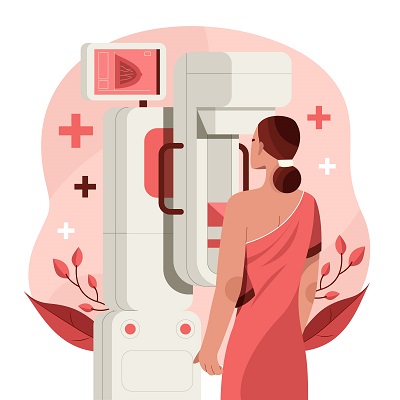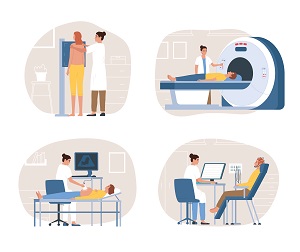The Automated Breast Ultrasound Systems (ABUS) Market is experiencing substantial growth, driven by advancements in technology and heightened awareness of breast cancer screening.ABUS offers a non-invasive, radiation-free imaging alternative that complements traditional mammography, proving particularly valuable for women with dense breast tissue where mammography may be less effective. As the global incidence of breast cancer increases, there is a growing emphasis on early detection and preventive strategies, which in turn boosts the demand for ABUS systems. Moreover, technological advancements have significantly improved the diagnostic capabilities and user-friendliness of ABUS systems, further accelerating market growth.
In addition, the market is highly competitive, with leading players investing heavily in research and development to advance ABUS technology. For instance, companies are integrating artificial intelligence and machine learning to enhance image interpretation and diagnostic accuracy, with the goal of reducing false positives and negatives. Consequently, these innovations are designed to make breast cancer screening more reliable. Furthermore, strategic partnerships, mergers, and acquisitions are common among market leaders as they seek to expand their product offerings and geographic reach.
Click here for more information: https://medicalmarketreport.com/report/global-automated-breast-ultrasound-systems-abus-market/#details
North America currently holds a significant share of the ABUS market, primarily due to its well-established healthcare infrastructure and high awareness of breast cancer screening. The region’s advanced medical facilities and large patient population collectively support its dominant position. In contrast, the Asia-Pacific region is projected to experience the highest growth rate. This growth is driven by increased healthcare investments, improving infrastructure, and a rising awareness of early breast cancer detection.
Nevertheless, the ABUS market faces several challenges. One major issue is the high costs associated with both purchasing and maintaining ABUS systems, which can limit their adoption in lower-income regions. Furthermore, there is a pressing need for extensive training for healthcare professionals to effectively utilize these advanced systems. To address these challenges, collaborative efforts among manufacturers, healthcare providers, and governments are essential. Such cooperation is crucial to making ABUS technology more accessible and affordable, thereby benefiting a broader segment of the population.
Get a Sample Copy of the Report to Know More: https://medicalmarketreport.com/report/global-automated-breast-ultrasound-systems-abus-market/#requestForSample
Key Market Segments:
Type:
1. Automated Breast Ultrasound Systems (ABUS): ABUS systems represent a significant segment of the market, providing comprehensive, 3D imaging of breast tissue without the use of radiation. These systems are particularly effective for detecting tumors in dense breast tissue, where traditional mammography might be less reliable. The segment benefits from continuous technological advancements, improving diagnostic accuracy and usability.
2. Automated Breast Volume Scanner (ABVS): ABVS is another crucial segment, offering automated, high-resolution imaging that captures a volume of breast tissue in a single scan. This technology provides detailed, three-dimensional images and is often used for its efficiency in screening large populations and its ability to complement mammography in routine breast cancer screenings.
3. Others: This category includes various other breast imaging technologies and systems that might not be classified strictly under ABUS or ABVS but contribute to the overall market. These could include manual breast ultrasound systems, hybrid imaging technologies, or emerging innovative devices in breast imaging.
Application:
1. Hospitals: Hospitals are a major application segment for ABUS systems, benefiting from the advanced diagnostic capabilities and the ability to integrate ABUS with other imaging modalities. Hospitals use ABUS for routine screenings, diagnostic imaging, and patient follow-ups, supporting comprehensive breast cancer management programs.
2. Diagnostic Imaging Centers: Diagnostic imaging centers represent another key application segment, where ABUS systems are employed to provide specialized breast imaging services. These centers focus on advanced diagnostic procedures and often use ABUS technology to enhance their screening and diagnostic capabilities, offering services to patients referred by primary care physicians and specialists.
Key Market Players in Automated Breast Ultrasound Systems (ABUS):
1. GE Healthcare:
GE Healthcare is a prominent player in the ABUS market, known for its advanced imaging technologies. The company offers state-of-the-art ABUS systems that integrate with other diagnostic tools, providing high-resolution, 3D breast imaging. GE Healthcare’s ABUS systems are designed to enhance early detection and diagnosis of breast cancer, particularly in patients with dense breast tissue.
2. Hitachi Ltd.:
Hitachi Ltd. is a key contributor to the ABUS market with its innovative imaging solutions. The company’s ABUS systems are recognized for their advanced automation and high-quality imaging capabilities. Hitachi focuses on developing technology that improves diagnostic accuracy and streamlines the breast imaging process.
3. Koninklijke Philips N.V.:
Philips is a leading player in the ABUS market, offering cutting-edge breast ultrasound systems that feature advanced imaging technology. Philips’ ABUS solutions are designed to provide detailed and accurate breast tissue imaging, supporting effective breast cancer screening and diagnostics.
4. Siemens AG:
Sophisticated ABUS systems from Siemens AG integrate the latest imaging technologies with AI and machine learning capabilities. Improving diagnostic precision and operational efficiency in breast cancer screening and diagnosis is the goal of Siemens’ ABUS solutions.
5. SonoCine Inc.:
SonoCine Inc. specializes in ABUS technology with a focus on automated, high-resolution breast imaging. The company’s systems are designed to enhance breast cancer detection, particularly in patients with dense breast tissue, and offer advanced imaging features for accurate diagnostics.
6. QView Medical, Inc.:
QView Medical offers innovative ABUS systems that provide high-quality, automated breast imaging. The company emphasizes user-friendly designs and advanced diagnostic capabilities to improve breast cancer screening and detection.
7. Seno Medical Instruments Inc.:
Seno Medical Instruments is known for its advanced ABUS systems that incorporate novel imaging technologies. The company focuses on developing systems that enhance breast cancer detection and diagnosis, offering high-resolution and detailed breast imaging solutions.
8. Volpara Solutions:
Volpara Solutions emphasizes precision and data analytics in its ABUS technology. The company designs its systems to integrate with other imaging modalities, providing detailed insights into breast tissue characteristics and supporting accurate diagnosis and treatment planning.
Key Regions:
- North America:(The US, Canada, Mexico)
- Western Europe:(Germany, France, The UK, Spain, Italy, Portugal, Ireland, Austria, Switzerland, Benelux, Nordic, Rest of Western Europe)
- Eastern Europe: (Russia, Poland, The Czech Republic, Greece, Rest of Eastern Europe)
- APAC: (China, Japan, South Korea, India, Australia & New Zealand, Indonesia, Malaysia, Philippines, Singapore, Thailand, Vietnam, Rest of APAC)
- Latin America:(Brazil, Colombia, Chile, Argentina, Costa Rica, Rest of Latin America)
- Middle East & Africa: (Algeria, Egypt, Israel, Kuwait, Nigeria, Saudi Arabia, South Africa, Turkey, United Arab Emirates, Rest of MEA)
Driver:
The primary driver of the Automated Breast Ultrasound Systems (ABUS) market is the escalating demand for early and accurate breast cancer detection.Although healthcare providers widely use traditional mammography, it often fails to identify tumors in women with dense breast tissue. In contrast, ABUS technology overcomes this limitation by offering a superior imaging option that delivers detailed, three-dimensional images of breast tissue without using radiation. This non-invasive approach proves particularly beneficial for detecting cancers that mammograms might obscure due to dense tissue.
Additionally, global increases in breast cancer awareness are placing more emphasis on early detection and preventive care. Public health campaigns, educational programs, and enhanced media coverage drive women to seek more effective screening options.
In addition, technological advancements in ABUS systems, such as improved image resolution, faster scan times, and user-friendly interfaces, further contribute to market growth. These innovations not only enhance the ability of healthcare professionals to diagnose breast cancer at an earlier stage but also improve treatment outcomes and patient survival rates.
Trend:
A prominent trend in the Automated Breast Ultrasound Systems (ABUS) market is the increasing integration of artificial intelligence (AI) and machine learning (ML) technologies. Advanced technologies are significantly transforming breast imaging by enhancing the diagnostic process. For instance, ABUS systems now incorporate AI and ML algorithms to improve image interpretation and diagnostic accuracy. These algorithms, in turn, can analyze vast amounts of imaging data, identify patterns, and highlight potential abnormalities with greater precision than traditional methods.
Furthermore, one of the key benefits of integrating AI into ABUS systems is its ability to reduce the rate of false positives and negatives. Consequently, by providing more accurate readings, AI helps decrease the likelihood of unnecessary biopsies and follow-up procedures, which can be both stressful and costly for patients. Additionally, AI-powered systems streamline the imaging workflow by automating routine tasks. As a result, radiologists are able to focus on more complex cases and interpretive work, which not only improves efficiency but also accelerates the diagnostic process. Consequently, this leads to quicker results and better patient care.
Restraint:
High costs associated with Automated Breast Ultrasound Systems (ABUS) significantly restrain market growth and accessibility. The substantial initial investment often makes these technologies inaccessible to smaller healthcare facilities in lower-income regions. Consequently, this cost barrier limits the widespread adoption of ABUS technology where it is most needed.
Additionally, ongoing maintenance and operational expenses add to the financial burden. To keep systems effective and accurate, institutions must regularly service them, update software, and train professionals. These recurring costs can be prohibitive for institutions with limited budgets, challenging the justification of investing in ABUS systems despite their advanced capabilities.
Opportunity:
The Automated Breast Ultrasound Systems (ABUS) market holds substantial growth opportunities, especially in emerging economies with improving healthcare infrastructure. As these regions invest in medical upgrades and expanded healthcare access, the demand for advanced diagnostic tools like ABUS grows.This demand arises as more people recognize the need for early breast cancer detection and improved screening methods.
Additionally, rising awareness about breast cancer significantly drives ABUS market growth in emerging economies. Public health campaigns, educational initiatives, and media coverage are raising awareness about breast cancer risks and early detection benefits. As awareness increases, more women are seeking advanced screening options, leading to higher adoption of ABUS technology.
Contact US:
Market.us (Powered By Prudour Pvt. Ltd.)
Address: 420 Lexington Avenue, Suite 300,
New York City, NY 10170, United States
Tel: +1 718 618 4351
Website: https://market.us/



